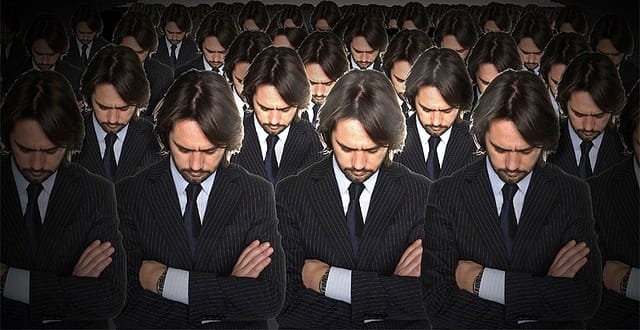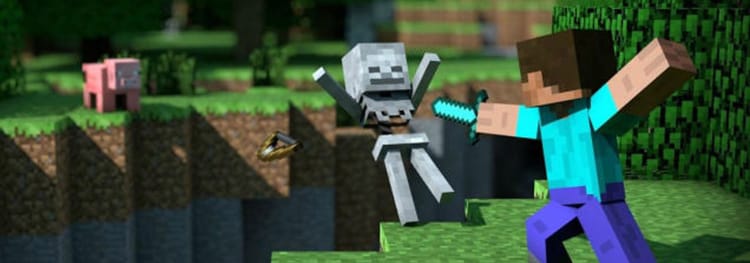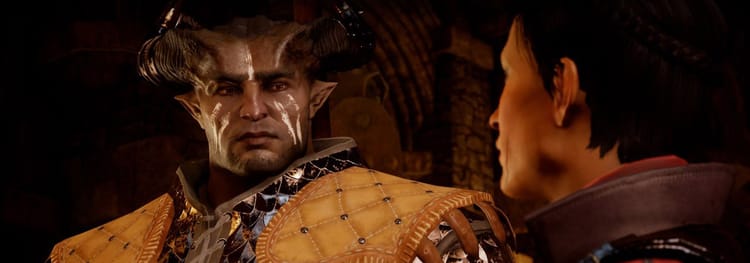Attack of the Clone Attackers

There is a dark moon rising in the world of games and it goes by one name: CLONES.
The rise of social and mobile platforms has lowered the barriers of entry to game development over the last few years, but it’s also been accompanied by the march of the walking dead. Tiny Tower maker NimbleBit screamed “CHEATER” at social-games giant Zynga for allegedly creating a copy called Dream Heights. (Another apparent clone called Small Street has already emerged as well.) Then there is the fleet of alleged Minecraft clones: Cube World, CraftWorld, Minebuilder, Minecrafted, and so on. And just this week, cloning turned to lawsuits as Spry Fox, maker of Triple Town, filed a copyright infringement suit against 6waves Lolapps for its alleged misappropriation Yeti Town.
Be warned. Copycats live among us.
The 1879 case of Baker vs. Selden deeply informed modern copyright law by introducing the concept of idea vs. expression. The case settled a dispute between two accountants, one of whom claimed that he owned the rights to a particular bookkeeping system. The Supreme Court deemed that the idea of the bookkeeping system could not be copywritten, but an expression of that system could. “You can’t copyright how to do something,” says James Grimmelmann, an associate professor at New York Law School. In music, for example, you can copyright a song (an expression) but not the blues (the idea).
What does that mean for games? Let’s use Scrabble as an example. The rules of the boardgame (the use of letters to gain points, the score multipliers, etc.) are not protected, but the game board with its colors is. Hence, Words With Friends. What is not allowed is plagiarism wherein you steal an entire game and try to pass it off as your own. A large publisher, for example, couldn’t take a game like Mass Effect 3 and change the title on the box to Space Dudes 3, and change nothing else. You could, however, make a game exactly like Mass Effect 3, with a similar story and similar characters, and Space Dudes can live on. (Long live Space Dudes.)
Game developers could pursue a patent to protect their technology, but Grimmelmann says that the entertainment nature of games makes that difficult. “Game mechanics fall into one of those areas that’s tricky in terms of how patent,” he says. Patents have to demonstrate their utility for the public, as well be completely novel. “So how do you explain something like entertainment value in games—how it’s not something anyone has done before, and more fun to begin with?” Grimmelman adds. “It’s hard to quantify the enjoyable properties in games.”
So it appears game makers are up a creek. But is cloning such a bad thing?
In the Tiny Tower and Minecraft examples, those are accusations of cosmetic changes to those games, but no one is stating that code has been stolen. The Spry Fox case is a notable exception in that both companies had been engaged with negotiations to publish the title, and according to Spry Fox’s complaint, when talks broke down, that’s when the clone went live. The whole thing is quite awful. But more often than not, accusations of plagiarism are the domain of the internet, where comparative screenshots are bandied about, but no legal recourse is taken.
Here’s another take: Cloning is healthy for the game industry. Let me explain.
Cloning protects the little guy. Can you imagine a world in which one could take legal recourse for game mechanics being stolen? That would mean no more platformers after Super Mario Bros., no more first-person shooters after Doom, no more real-time strategy games after Command & Conquer. Brian Reynolds, Zynga’s game design chief, levied a similar argument when responding to accusations of cloning:
Actually you know, some of the best games ever made, I’ve felt like were actually, the best way to put it—the most favorable way to put it—might be a “glorious synthesis” of stuff in previous games. I bought the very first Civilization, I think one of the greatest games really of all time. I felt like, “Hey wow, what a great synthesis between the Empire game from the PC and the Civilization board game, you know? So it was like some of this and some of that, and then some completely new stuff thrown in.
Providing the legal and cultural breadth for appropriation allows people to build upon old products in the hope of creating new ones. Deny that right, and you deny the possibility for the next breakthrough. More importantly, large companies could wield copyright over, say, the cover mechanic in Gears of War much more easily than your neighborhood iOS developer.
Cloning identifies good ideas. “Good artists copy, great artists steal,” Steve Jobs said in 1994, amending a quote from the poet T.S. Eliot. As part of a large package for Salon on “What is Plagiarism?,” Tim Perfect, a professor at the University of Plymouth, points out that not just any ideas are stolen:
Instead, plagiarism during creative tasks is influenced by the status of the source of the idea. In studies when people hear ideas from two different people, one expert, one not, they are twice as likely to plagiarize from the expert than from the novice. This happens even though there is no objective difference in the quality of the ideas from the two sources. Thus, the evidence suggests that people don’t plagiarize good ideas so much as ideas from good places. Imitation truly is the sincerest form of flattery!
People don’t clone bad ideas, only good ones. The clones of Minecraft are, in fact, a public demonstration that Mojang had stumbled upon something brilliant. A strange type of consolation, but an affirmation nonetheless.
The problem isn’t cloning. It’s credit. When Andy Moore who faced a clone of his game Steambirds by a Frenchman who had renamed a version of it as Fly or Die, he was devastated: “This was my first big game and I’m very possessive about it. [Steambirds] came from my heart. Now, someone’s taken that spirit and passion and tore it from me. I felt a little bit empty.”
Moore had spent hours making Steambirds just right, and now someone else had taken a shortcut to use what works. By any approximation, this is a tragedy—but moral right shouldn’t be confused with legal right. Game designers are responding to a moral repulsion that they alone feel. It is the pain of craftsmen, in a world where their craft isn’t understood.
What game designers really need is to ask cloners to own up for acknowledgement, not for them to take their games offline.
But compare the dialogue around gaming to that in art. Virginia Rutledge, an art lawyer and former general counsel for Creative Commons, a nonprofit group that fights for more open copyright standards, said in a debate that she believed that the problem facing the art world was a “cultural attribution crisis.” The problem was that credit wasn’t given where credit was actually due. What game designers really need is to ask cloners to own up for acknowledgement, not for them to take their games offline.
Cloning shows that game designers need stronger identities. There is, of course, a monetary penalty to cloning. A confused public chooses a game that looks or sounds like a popular title, and pulls money from an “original” title to its clone. In its complaint, Spry Fox is seeking more than $100,000 in damages and an alleged $500,000 in profits that its clone generated.
Again, this confusion points to a larger identity problem in games. They are still a faceless occupation, and the lack of personality around their creation makes cloning a more likely problem. Even many independent games, unmoored from the marketing constraints of majors, are marketed by title or by franchise, not by creator or by studio.
Have you heard of the film production company Asylum? You may know it for such blockbuster films as Transmorphers, The Da Vinci Treasure, and Snakes on a Train. Sound familiar? They are deliberate copies of popular films with cheap, lackluster special effects and tepid acting. Studio founder David Michael Latt told the New York Times:
“I’m not trying to dupe anybody,” he says. “I’m just trying to get my films watched. Other people do tie-ins all the time; they’re just better at being subtle about it. Another studio might make a giant robot movie that ties into the ‘Transformers’ release and call it ‘Robot Wars.’ We’ll call ours ‘Transmorphers.’ “
The point is that no one would mistake Asylum’s films for actual blockbusters (in large part due to low-quality FX), but more importantly, the cultural literacy around film is much higher than it is for games. In other industries, copycats are identified as derivatives and aren’t given the same credit as the original creators. Both live in the same ecosystem and both may be commercially successful, but only the originator is hailed by critics. The public understands a B-movie as a filmic trope. That’s why Michael Bay doesn’t feel the monetary pinch from cloners. The public knows his work and knows well enough to stay clear of impostors.
Providing the legal and cultural breadth for appropriation allows people to build upon old products in the hope of creating new ones. Deny that right, and you deny the possibility for the next breakthrough.
Fashion points the way to a possible solution. Cloning is rampant, as runway styles are constantly ripped by also-ran fashion outlets. Anthony Falzone, a lecturer in law at Stanford and the executive director of Fair Use Project, told me: “In fashion, there’s prestige, desire, and the mystique of brands. Forever 21 can knock off Prada, but people who buy Prada will know the difference.”
Shouldn’t we expect the same from our games as well? Shouldn’t we, as a game-buying public, be able to tell the difference between Minecraft and its clone?
Rather than going after cloners, game designers should be targeting the institutions that enhance the public’s understanding of what games are and how they work. Those are the places where “credit” is handed out: that means schools, museums, and media organizations that often don’t have passing knowledge of how games are even made. Game designers should be partnering more with museums, inviting non-game designers like musicians into their world, and teaching students about their craft.
Grimmelmann adds that literacy around games is paramount to dealing with cloners. “We won’t make Zynga go away,” he says. “They’re doing something that is shameful. Maybe it gets people playing games, but there’s a better way, and people who make games artistically ought to have commercial audiences.” An informed public is a powerful public, and the only way to stop clones is to disgrace them. But that conversation only works if all who play games are onboard, not just those that make them.
The problem isn’t with clones. The problem is with us.
Image by Asha ten Broeke



